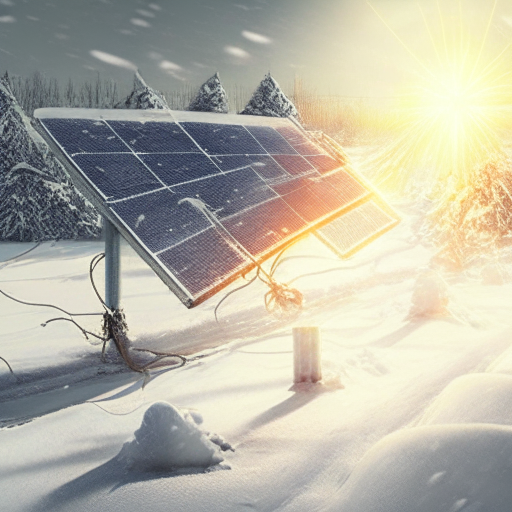Maximize Solar Energy Efficiency in Cold Weather: Proven Strategies for Survivalists
As a dedicated survivalist, you understand the critical importance of achieving self-sufficiency, especially when faced with the challenges posed by harsh winter conditions. One of the most pressing issues you might encounter is how to effectively harness renewable energy sources in freezing temperatures. The cold can seem like a formidable barrier, but there’s no need to worry! This article will delve into the underutilized opportunities of solar power in colder climates. We will equip you with actionable strategies that empower you to effectively capture solar energy, even in the harshest winter environments, by adopting a proactive and well-researched approach tailored to your needs.

Many people mistakenly believe that solar electricity is only viable in warm, sunny regions. However, advancements in technology have made it entirely feasible to capture solar energy even in the coldest climates. In the following sections, we will explore the various methods that enable solar power systems to excel in extreme cold and how you can utilize this sustainable, eco-friendly energy source to enhance your lifestyle and survival strategies effectively. By understanding these techniques, you can tap into the potential of solar energy regardless of the weather conditions.
To begin with, it is vital to recognize that solar panels generate energy from sunlight rather than temperature. While cooler conditions may influence the efficiency of solar panels, they do not make them ineffective during winter months. Through strategic planning and innovative techniques, you can significantly enhance the performance of your solar power system, ensuring it operates optimally even in the coldest climates. By comprehending the mechanics of solar panel functionality across different temperatures, you will be empowered to make informed decisions that effectively meet your energy requirements while maximizing output.
One of the key factors in optimizing solar electricity in cold climates is the angle and orientation of your solar panels. Proper positioning can substantially increase the amount of sunlight your panels absorb throughout the day. In winter, the sun’s trajectory is lower in the sky, making it essential to tilt your panels at a steeper angle to capture maximum sunlight. This adjustment not only enhances their efficiency but also ensures that they can harness the available light during shorter winter days. Additionally, orienting your panels toward the south can further optimize their sunlight collection capabilities, allowing for greater energy production even in challenging conditions.
Snow accumulation poses a significant challenge in colder regions, as it can obstruct the effectiveness of your solar panels. A thick layer of snow can dramatically decrease electricity output. However, by proactively addressing this issue, you can implement effective solutions. Consider installing snow barriers or heating elements on your solar panels to prevent snow buildup. These enhancements can facilitate the melting of existing snow while ensuring continuous energy production, even during snowstorms. Regular manual snow clearance can also be a practical maintenance strategy to keep your panels operating optimally and free from obstructions that could reduce their efficiency.
Incorporating battery storage systems is a forward-thinking strategy to enhance solar power efficiency in cold conditions. These batteries store excess energy generated during daylight hours, making it available for use when sunlight is scarce or temperatures drop. The significance of battery storage becomes particularly pronounced during freezing conditions, as it guarantees a reliable supply of electricity when it is needed most. By investing in a dependable battery system, you can maintain your energy independence and be well-equipped for any unforeseen circumstances that may arise during severe weather events.
Selecting the right type of solar panels is essential for optimizing the efficiency of your solar energy system in cold climates. Certain panels are specifically designed to perform better in lower temperatures and may include enhanced insulation or specialized materials that minimize the impact of frost and ice on their effectiveness. By making an informed decision about the types of panels that best suit your cold environment, you can maximize energy production and ensure that your solar power system effectively meets your energy demands without compromise.
Beyond technical considerations, it is crucial to have your solar power system installed by professionals who are experienced in cold climate conditions. Skilled installers can provide valuable best practices for installation, ongoing maintenance, and troubleshooting, offering insights that are essential for optimizing your system. Their expertise ensures that your solar setup operates at peak efficiency, even under the harshest winter conditions, ultimately enhancing the reliability of your energy source and ensuring you have access to sustainable power when you need it most.
Maintaining a proactive and prepared mindset is vital in survival scenarios. While solar power can serve as a dependable and effective energy source in cold climates, having backup generators or alternative energy solutions is also essential. These additional measures can serve as a safety net during extended periods of low sunlight or unexpected system failures. By integrating solar power with other renewable energy sources, you can further bolster your energy independence and resilience, ensuring you are well-equipped to handle any weather-related challenges that may arise.
Solar energy is not limited to warm and sunny areas; it holds tremendous potential even in the coldest climates, provided it is strategically planned and technically advanced. By adjusting your panel angles, addressing snow accumulation, utilizing battery storage, selecting appropriate solar panels, relying on professional installation, and establishing contingency plans, you can unlock the complete potential of solar energy in extreme cold. Embrace renewable energy confidently and resourcefully, securing your survival and sustainability in any climate.
The post Solar Energy in Extreme Cold: Unlocking Its Full Potential appeared first on Survival Bite.
The Article Solar Energy’s Full Potential in Extreme Cold Conditions Was Found On https://limitsofstrategy.com


This is such an essential topic, especially as we brace for the colder months ahead. As a fellow survivalist, I’ve often found myself grappling with similar concerns regarding energy sustainability during winter. It’s intriguing to see how many misconceptions linger around solar energy in colder climates, where people tend to equate low temperatures with low energy capture.
You’re touching on a key issue that often gets overlooked. Many people assume that the colder months equate to decreased solar energy potential, which is a major misconception. Cold temperatures can actually improve the efficiency of solar panels since they work better when it’s cooler, as long as there’s enough sunlight. This is often not recognized, leading folks to dismiss solar energy in winter settings.
It’s true that misconceptions around solar energy in colder climates can be pretty frustrating, especially for those of us who are focused on energy sustainability. It’s interesting how people often think that solar panels won’t perform well when it’s chilly outside. In reality, they can actually be more efficient in cooler temperatures, as long as there’s sufficient sunlight. I remember reading about a solar farm in Alberta, Canada, that thrived through the winter months.
You hit the nail on the head about solar panels in colder climates. It’s wild how many folks still believe that if it’s chilly, solar energy doesn’t work as well. The truth is, cold weather can actually help solar panels run more efficiently. If you think about it, when the temperatures drop, the panels can convert sunlight into electricity better, provided there’s enough sunlight to begin with.
You make a really good point about solar panels in colder climates. It’s interesting how perceptions can sometimes overshadow the facts. I read somewhere that the efficiency of solar panels actually tends to improve in cooler temperatures, so it’s kind of a myth that they only thrive in warmer weather. I wonder how many people actually know that.
You raise some excellent points about the misconceptions surrounding solar energy, especially in colder climates. It’s fascinating how temperature can influence performance, isn’t it? Many people might not realize that solar panels actually operate more efficiently in cooler temperatures compared to scorching heat. When you combine that with ample sunlight—which, as you mentioned, can still be abundant during winter months—it creates a much more nuanced understanding of solar energy.
You’re spot on about the winter energy struggle. It’s funny how people think just because the sun’s taking a little winter snooze, it’s not still capable of working its magic. For those of us in colder climates, it’s like expecting a snowman to fight off summer heat. Solar panels can totally function when it’s chilly; they just have a different vibe when it comes to energy capture.
You make a great point about the misconceptions around solar energy in the winter. It’s interesting how our understanding of renewable energy can often be overshadowed by seasonal stereotypes. There’s definitely a learning curve for many when it comes to recognizing that solar panels don’t necessarily need direct sunlight to be effective. In fact, I’ve read that they can actually perform quite well in cooler temperatures—it’s more about the amount of daylight than the warmth.
You hit the nail on the head with that winter misconception. It’s almost like we think solar panels hibernate like bears until spring rolls around. The idea that they can actually harness energy in cooler temperatures is a lightbulb moment for many folks.
You’re spot on about the misconceptions around solar energy in colder weather. A lot of folks think that just because it’s snowy or chilly, solar panels aren’t pulling in energy. The truth is, while efficiency can drop with snow covering them, they can actually perform well in cold weather, especially when it’s sunny. The brightness of the sun reflecting off the snow can be quite beneficial.
It’s refreshing to hear from someone who shares a similar mindset about navigating the challenges of colder months. The misconceptions surrounding solar energy in winter are a significant hurdle that many folks have to overcome. It’s easy to think that when the temperatures drop and the days get shorter, solar panels are just not up to the task. But in reality, solar technology has come a long way, and there are a number of factors at play that can still make them a viable energy source even in chillier conditions.
You’re spot on about the misconceptions surrounding solar energy in colder climates. A lot of folks assume that when the temperature drops, solar panels just stop working. But in reality, they can actually perform well in the cold, as long as there’s enough sunlight. The efficiency can even increase because colder conditions help them operate better.
You’re right about that common misconception regarding solar panels in colder climates. It’s interesting how many people tend to associate solar energy solely with warm, sunny days. I’ve read studies showing that while efficiency can increase in cooler temperatures, it’s really the amount of sunlight that makes the biggest difference in performance.
You hit the nail on the head with that point about sunlight being the real game changer. It’s pretty fascinating how these panels can actually perform better when it’s cooler outside, but people often overlook how critical direct sunlight is for overall output. In places where it snows, those panels can still collect energy quite effectively, especially when they’re angled to catch the light. Plus, snow can actually help by reflecting sunlight back onto the panels! It’s cool to think that even in less-than-ideal conditions, there’s a lot going on behind the scenes. That makes me wonder how many folks could benefit from solar energy up north if they just knew a bit more about how it works.
This is such an important topic! As someone who has been experimenting with solar setups in a colder climate, I’ve noticed how often people underestimate solar’s capabilities in winter. I’ve found that incorporating solar panels on a tilt can make a huge difference in capturing sunlight when the days are short and the angles of the sun are lower. I also invested in snow resistant panels, which helps with efficiency after a snowfall.
Your insights into maximizing solar energy efficiency in cold weather resonate deeply with the challenges many survivalists face. I’ve often found that a common misconception is the belief that solar power is limited to bright, warm days. In my own experience living in a region with harsh winters, I’ve learned firsthand how solar panels can still be effective despite snow and lower temperatures.
It’s great to hear your thoughts on maximizing solar energy efficiency in cold weather. Many people do hold that misconception about solar power being strictly for those bright, sunny days. Your experience in a harsh winter region really highlights how solar panels can perform even in challenging conditions.
It’s interesting how many people still cling to the idea that solar energy is only for sunny climates. Living in a harsher winter region has definitely changed my perspective. I’ve been surprised by how well my solar panels perform even on overcast days or when there’s snow on the ground. It’s a reminder of how resilient technology can be, especially when we embrace it in diverse environments.
It’s interesting how often people underestimate the resilience of solar energy, especially in colder climates. I can relate to your experiences with solar panels in harsh winters. Living in a place that gets heavy snowfall, I initially worried about how the panels would perform when covered. But I’ve been pleasantly surprised by their efficiency even on cloudy days. The misconception that solar power requires constant sunshine is so widespread, yet many don’t realize that solar panels can still generate power in diffused light.
Your experience really highlights a key point about solar energy that deserves more attention. It’s fascinating how people often jump to conclusions about technology based on assumptions rather than facts. In many places with harsh winter weather, solar panels adapt surprisingly well. They’re designed to work across a range of conditions, and as you mentioned, panels can capture and convert diffused light effectively.